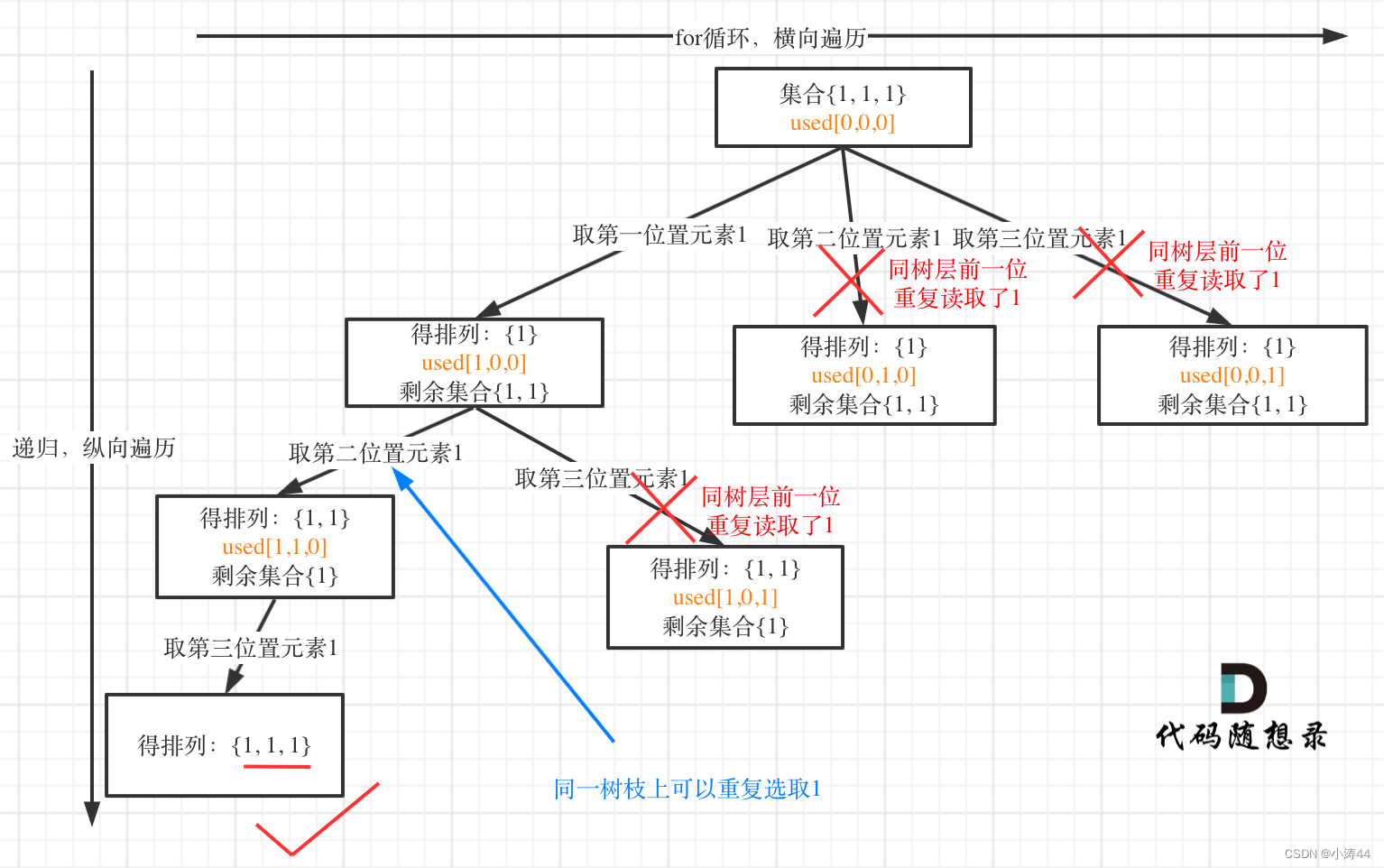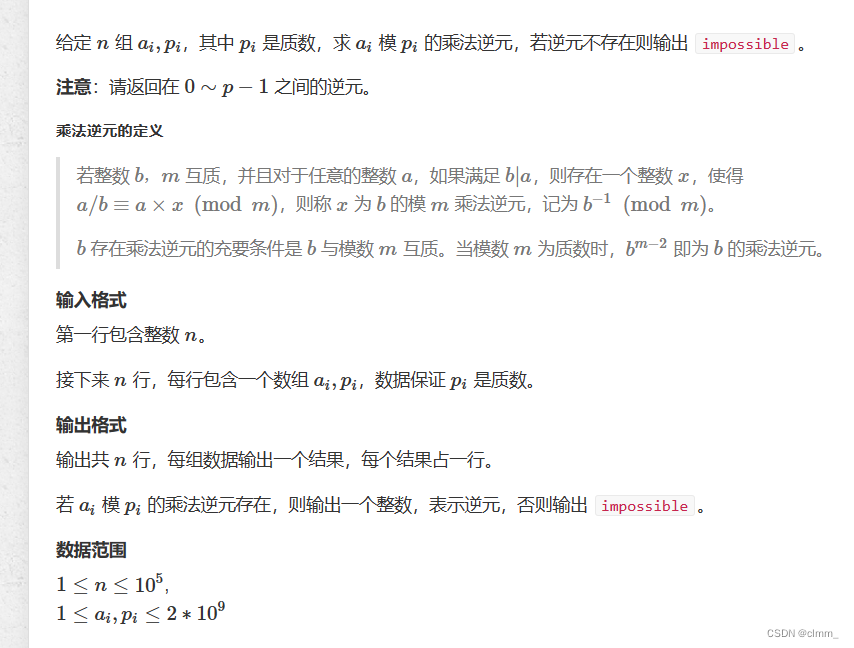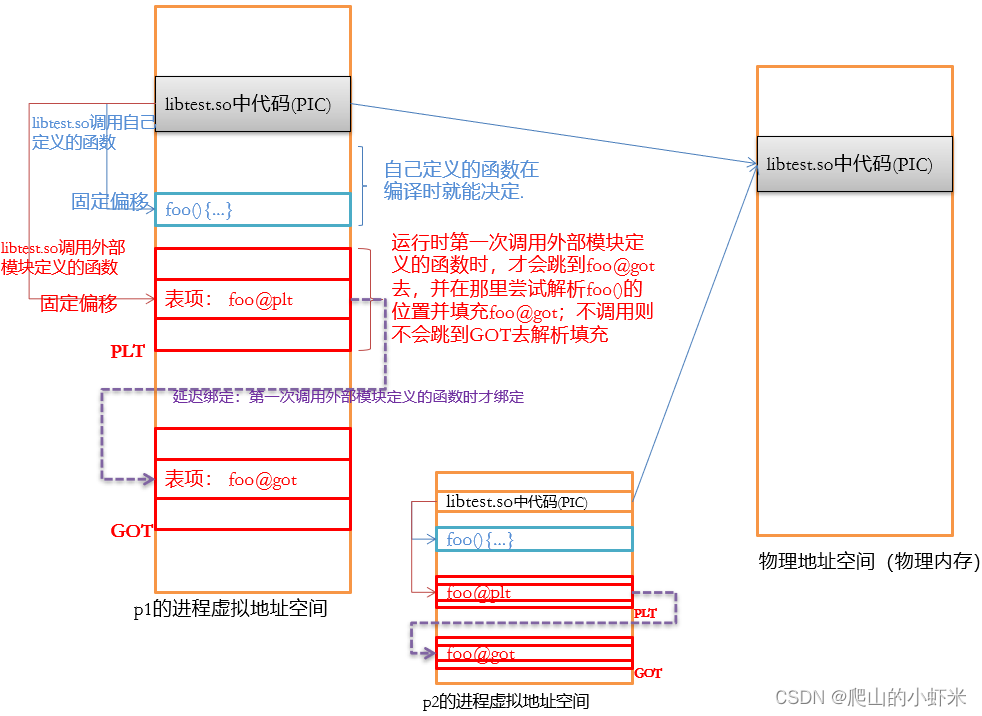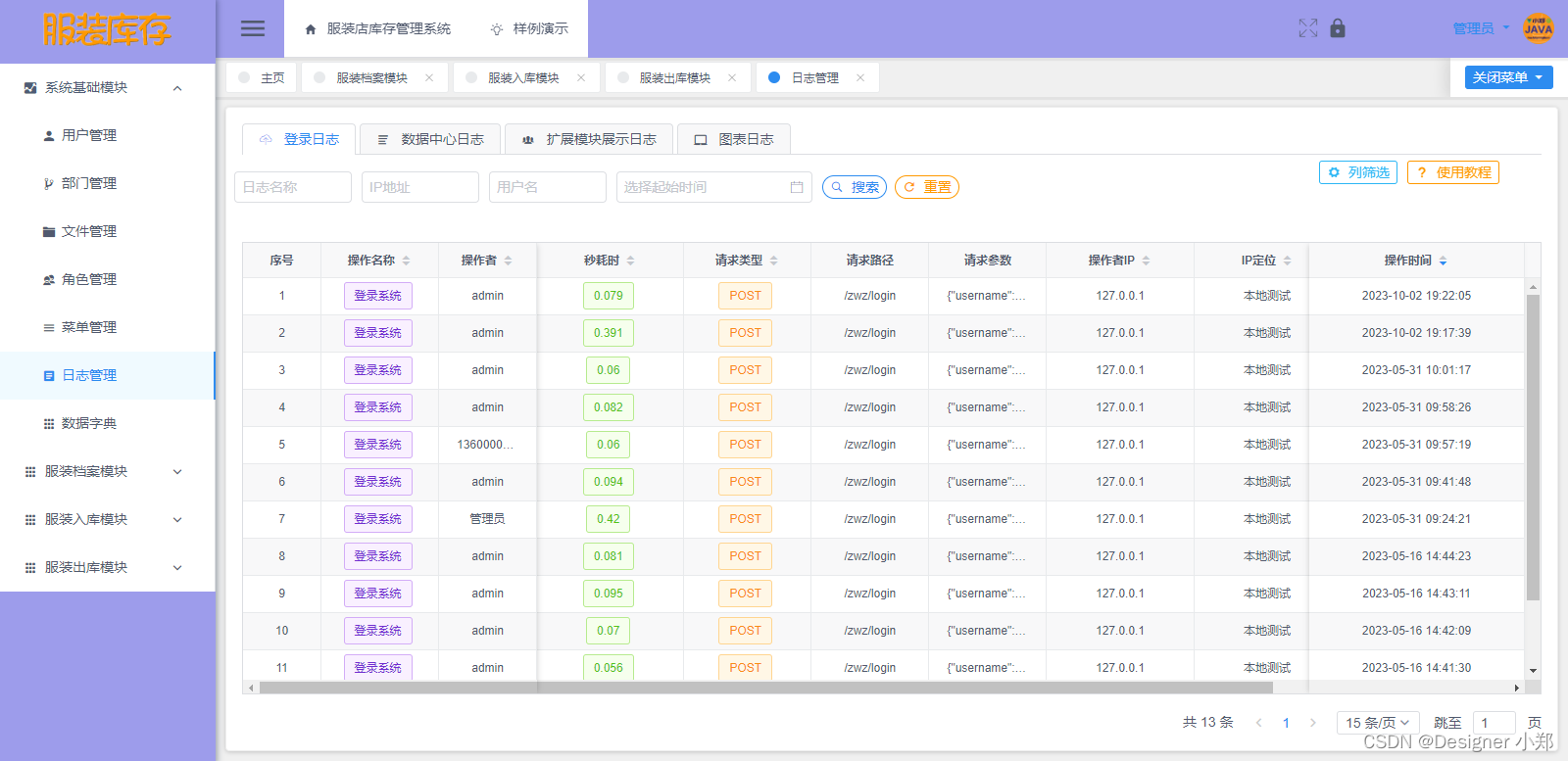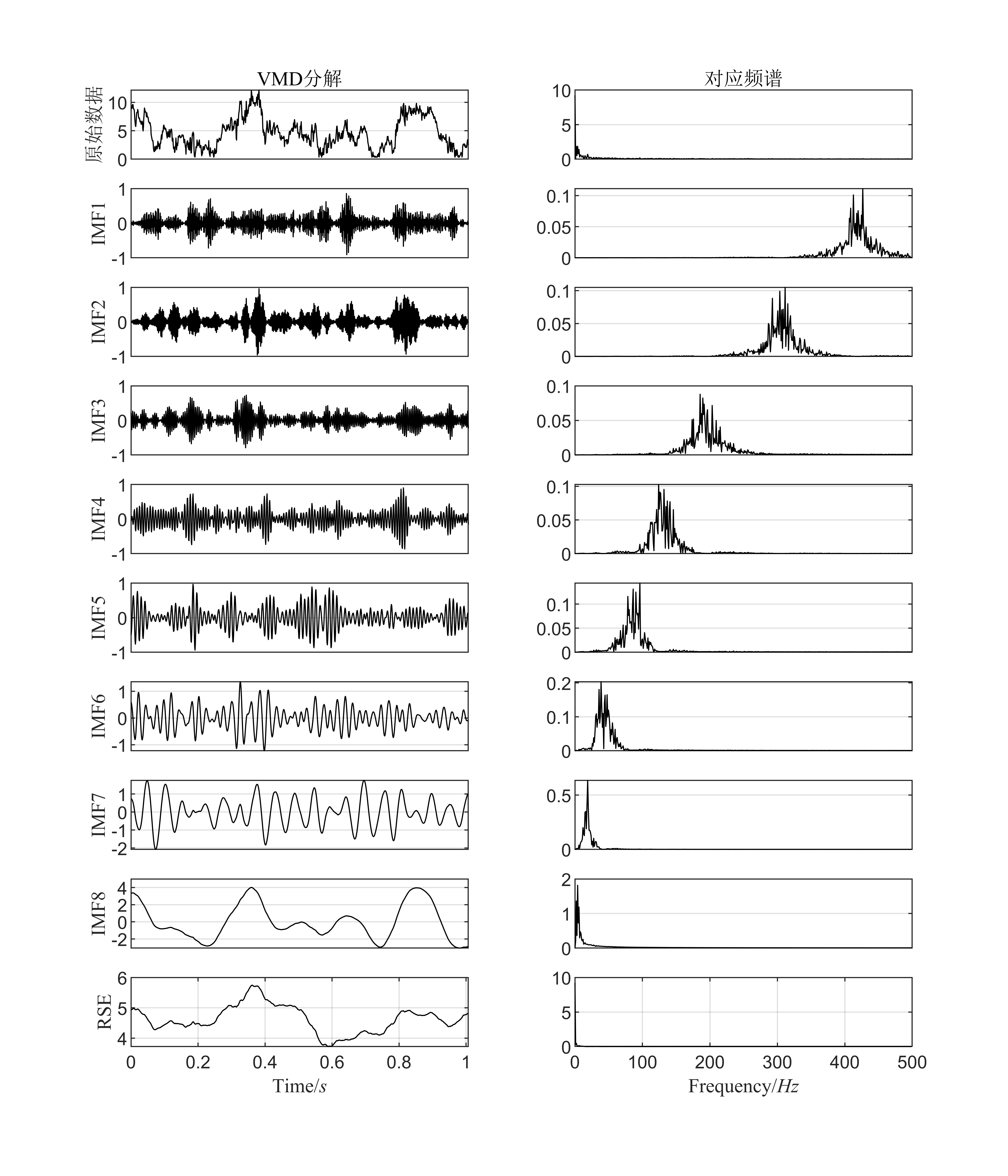文章目录
- 一、Nginx 的相关组件介绍
- 1.1、ngx_palloc相关源码
- 1.2、ngx_array组件的相关源码
- 1.3、ngx_array的数据结构
- 1.4、ngx_cycle简介和相关源码
- 1.5、ngx_list相关源码
- 1.6、ngx_list 的数据结构
- 二、Nginx 组件的使用
- 2.1、makefile的编写
- 2.2、ngx_palloc+ngx_array的使用
- 2.3、ngx_palloc+ngx_list的使用
- 总结
一、Nginx 的相关组件介绍
Nginx自己实现了一个内存池组件。Nginx作为服务器,当客户端 TCP连接 &HTTP请求 到来时,Nginx会为该连接创建一个专属的内存池;这个内存池的生命周期是连接建立时创建,连接断开时销毁。客户端和Nginx通信的所有数据和操作(HTTP协议解析、HTTP数据解析等)都在内存池中完成。
1.1、ngx_palloc相关源码
/src/core/ngx_palloc.h。(相关实现在/src/core/ngx_palloc.c文件)
#ifndef _NGX_PALLOC_H_INCLUDED_
#define _NGX_PALLOC_H_INCLUDED_
#include <ngx_config.h>
#include <ngx_core.h>
/*
* NGX_MAX_ALLOC_FROM_POOL should be (ngx_pagesize - 1), i.e. 4095 on x86.
* On Windows NT it decreases a number of locked pages in a kernel.
*/
#define NGX_MAX_ALLOC_FROM_POOL (ngx_pagesize - 1)
#define NGX_DEFAULT_POOL_SIZE (16 * 1024)
#define NGX_POOL_ALIGNMENT 16
#define NGX_MIN_POOL_SIZE \
ngx_align((sizeof(ngx_pool_t) + 2 * sizeof(ngx_pool_large_t)), \
NGX_POOL_ALIGNMENT)
typedef void (*ngx_pool_cleanup_pt)(void *data);
typedef struct ngx_pool_cleanup_s ngx_pool_cleanup_t;
struct ngx_pool_cleanup_s {
ngx_pool_cleanup_pt handler;
void *data;
ngx_pool_cleanup_t *next;
};
typedef struct ngx_pool_large_s ngx_pool_large_t;
struct ngx_pool_large_s {
ngx_pool_large_t *next;
void *alloc;
};
typedef struct {
u_char *last;
u_char *end;
ngx_pool_t *next;
ngx_uint_t failed;
} ngx_pool_data_t;
struct ngx_pool_s {
ngx_pool_data_t d;
size_t max;
ngx_pool_t *current;
ngx_chain_t *chain;
ngx_pool_large_t *large;
ngx_pool_cleanup_t *cleanup;
ngx_log_t *log;
};
typedef struct {
ngx_fd_t fd;
u_char *name;
ngx_log_t *log;
} ngx_pool_cleanup_file_t;
ngx_pool_t *ngx_create_pool(size_t size, ngx_log_t *log);
void ngx_destroy_pool(ngx_pool_t *pool);
void ngx_reset_pool(ngx_pool_t *pool);
void *ngx_palloc(ngx_pool_t *pool, size_t size);
void *ngx_pnalloc(ngx_pool_t *pool, size_t size);
void *ngx_pcalloc(ngx_pool_t *pool, size_t size);
void *ngx_pmemalign(ngx_pool_t *pool, size_t size, size_t alignment);
ngx_int_t ngx_pfree(ngx_pool_t *pool, void *p);
ngx_pool_cleanup_t *ngx_pool_cleanup_add(ngx_pool_t *p, size_t size);
void ngx_pool_run_cleanup_file(ngx_pool_t *p, ngx_fd_t fd);
void ngx_pool_cleanup_file(void *data);
void ngx_pool_delete_file(void *data);
#endif /* _NGX_PALLOC_H_INCLUDED_ */
/src/core/ngx_palloc.c
void *
ngx_array_push(ngx_array_t *a)
{
void *elt, *new;
size_t size;
ngx_pool_t *p;
if (a->nelts == a->nalloc) {
/* the array is full */
size = a->size * a->nalloc;
p = a->pool;
if ((u_char *) a->elts + size == p->d.last
&& p->d.last + a->size <= p->d.end)
{
/*
* the array allocation is the last in the pool
* and there is space for new allocation
*/
p->d.last += a->size;
a->nalloc++;
} else {
/* allocate a new array */
new = ngx_palloc(p, 2 * size);
if (new == NULL) {
return NULL;
}
ngx_memcpy(new, a->elts, size);
a->elts = new;
a->nalloc *= 2;
}
}
elt = (u_char *) a->elts + a->size * a->nelts;
a->nelts++;
return elt;
}
/src/core/ngx_core.h
// ...
typedef struct ngx_pool_s ngx_pool_t;
// ...
1.2、ngx_array组件的相关源码
/src/core/ngx_array.h
/*
* Copyright (C) Igor Sysoev
* Copyright (C) Nginx, Inc.
*/
#ifndef _NGX_ARRAY_H_INCLUDED_
#define _NGX_ARRAY_H_INCLUDED_
#include <ngx_config.h>
#include <ngx_core.h>
typedef struct {
void *elts;
ngx_uint_t nelts;
size_t size;
ngx_uint_t nalloc;
ngx_pool_t *pool;
} ngx_array_t;
ngx_array_t *ngx_array_create(ngx_pool_t *p, ngx_uint_t n, size_t size);
void ngx_array_destroy(ngx_array_t *a);
void *ngx_array_push(ngx_array_t *a);
void *ngx_array_push_n(ngx_array_t *a, ngx_uint_t n);
static ngx_inline ngx_int_t
ngx_array_init(ngx_array_t *array, ngx_pool_t *pool, ngx_uint_t n, size_t size)
{
/*
* set "array->nelts" before "array->elts", otherwise MSVC thinks
* that "array->nelts" may be used without having been initialized
*/
array->nelts = 0;
array->size = size;
array->nalloc = n;
array->pool = pool;
array->elts = ngx_palloc(pool, n * size);
if (array->elts == NULL) {
return NGX_ERROR;
}
return NGX_OK;
}
#endif /* _NGX_ARRAY_H_INCLUDED_ */
1.3、ngx_array的数据结构
typedef struct {
void *elts;
ngx_uint_t nelts;
size_t size;
ngx_uint_t nalloc;
ngx_pool_t *pool;
} ngx_array_t;
elts:指向内存数据的指针。
nelts:指示已使用了多少个元素。
size:数组元素的大小。
nalloc:分配的元素数量。
pool:内存池。
array在内存里的布局:
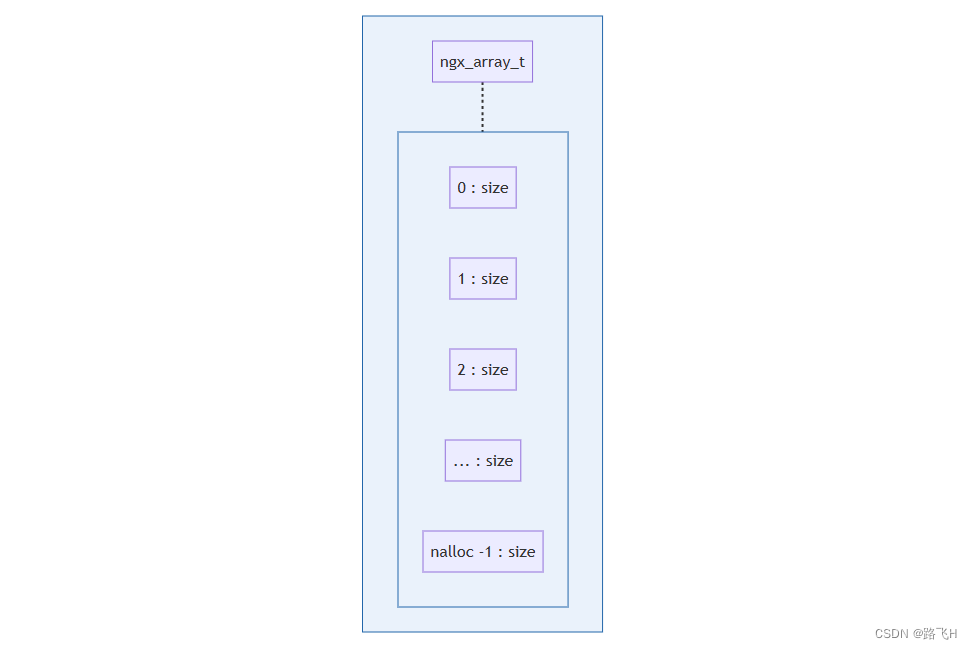
1.4、ngx_cycle简介和相关源码
Nginx的每个进程内部都有一个自己的ngx_cycle。
/src/core/ngx_cycle.h
#ifndef _NGX_CYCLE_H_INCLUDED_
#define _NGX_CYCLE_H_INCLUDED_
#include <ngx_config.h>
#include <ngx_core.h>
#ifndef NGX_CYCLE_POOL_SIZE
#define NGX_CYCLE_POOL_SIZE NGX_DEFAULT_POOL_SIZE
#endif
#define NGX_DEBUG_POINTS_STOP 1
#define NGX_DEBUG_POINTS_ABORT 2
typedef struct ngx_shm_zone_s ngx_shm_zone_t;
typedef ngx_int_t (*ngx_shm_zone_init_pt) (ngx_shm_zone_t *zone, void *data);
struct ngx_shm_zone_s {
void *data;
ngx_shm_t shm;
ngx_shm_zone_init_pt init;
void *tag;
ngx_uint_t noreuse; /* unsigned noreuse:1; */
};
struct ngx_cycle_s {
// ...
};
typedef struct {
// ...
} ngx_core_conf_t;
#define ngx_is_init_cycle(cycle) (cycle->conf_ctx == NULL)
ngx_cycle_t *ngx_init_cycle(ngx_cycle_t *old_cycle);
ngx_int_t ngx_create_pidfile(ngx_str_t *name, ngx_log_t *log);
void ngx_delete_pidfile(ngx_cycle_t *cycle);
ngx_int_t ngx_signal_process(ngx_cycle_t *cycle, char *sig);
void ngx_reopen_files(ngx_cycle_t *cycle, ngx_uid_t user);
char **ngx_set_environment(ngx_cycle_t *cycle, ngx_uint_t *last);
ngx_pid_t ngx_exec_new_binary(ngx_cycle_t *cycle, char *const *argv);
ngx_cpuset_t *ngx_get_cpu_affinity(ngx_uint_t n);
ngx_shm_zone_t *ngx_shared_memory_add(ngx_conf_t *cf, ngx_str_t *name,
size_t size, void *tag);
void ngx_set_shutdown_timer(ngx_cycle_t *cycle);
extern volatile ngx_cycle_t *ngx_cycle;
extern ngx_array_t ngx_old_cycles;
extern ngx_module_t ngx_core_module;
extern ngx_uint_t ngx_test_config;
extern ngx_uint_t ngx_dump_config;
extern ngx_uint_t ngx_quiet_mode;
#endif /* _NGX_CYCLE_H_INCLUDED_ */
1.5、ngx_list相关源码
/src/core/ngx_list.h
#ifndef _NGX_LIST_H_INCLUDED_
#define _NGX_LIST_H_INCLUDED_
#include <ngx_config.h>
#include <ngx_core.h>
typedef struct ngx_list_part_s ngx_list_part_t;
struct ngx_list_part_s {
void *elts;
ngx_uint_t nelts;
ngx_list_part_t *next;
};
typedef struct {
ngx_list_part_t *last;
ngx_list_part_t part;
size_t size;
ngx_uint_t nalloc;
ngx_pool_t *pool;
} ngx_list_t;
ngx_list_t *ngx_list_create(ngx_pool_t *pool, ngx_uint_t n, size_t size);
static ngx_inline ngx_int_t
ngx_list_init(ngx_list_t *list, ngx_pool_t *pool, ngx_uint_t n, size_t size)
{
list->part.elts = ngx_palloc(pool, n * size);
if (list->part.elts == NULL) {
return NGX_ERROR;
}
list->part.nelts = 0;
list->part.next = NULL;
list->last = &list->part;
list->size = size;
list->nalloc = n;
list->pool = pool;
return NGX_OK;
}
/*
*
* the iteration through the list:
*
* part = &list.part;
* data = part->elts;
*
* for (i = 0 ;; i++) {
*
* if (i >= part->nelts) {
* if (part->next == NULL) {
* break;
* }
*
* part = part->next;
* data = part->elts;
* i = 0;
* }
*
* ... data[i] ...
*
* }
*/
void *ngx_list_push(ngx_list_t *list);
#endif /* _NGX_LIST_H_INCLUDED_ */
1.6、ngx_list 的数据结构
typedef struct ngx_list_part_s ngx_list_part_t;
struct ngx_list_part_s {
void *elts;
ngx_uint_t nelts;
ngx_list_part_t *next;
};
typedef struct {
ngx_list_part_t *last;
ngx_list_part_t part;
size_t size;
ngx_uint_t nalloc;
ngx_pool_t *pool;
} ngx_list_t;
elts:指向内存数据的指针。
nelts:指示已使用了多少个元素。
size:数组元素的大小。
nalloc:分配的元素数量。
pool:内存池。
list 在内存里的布局:
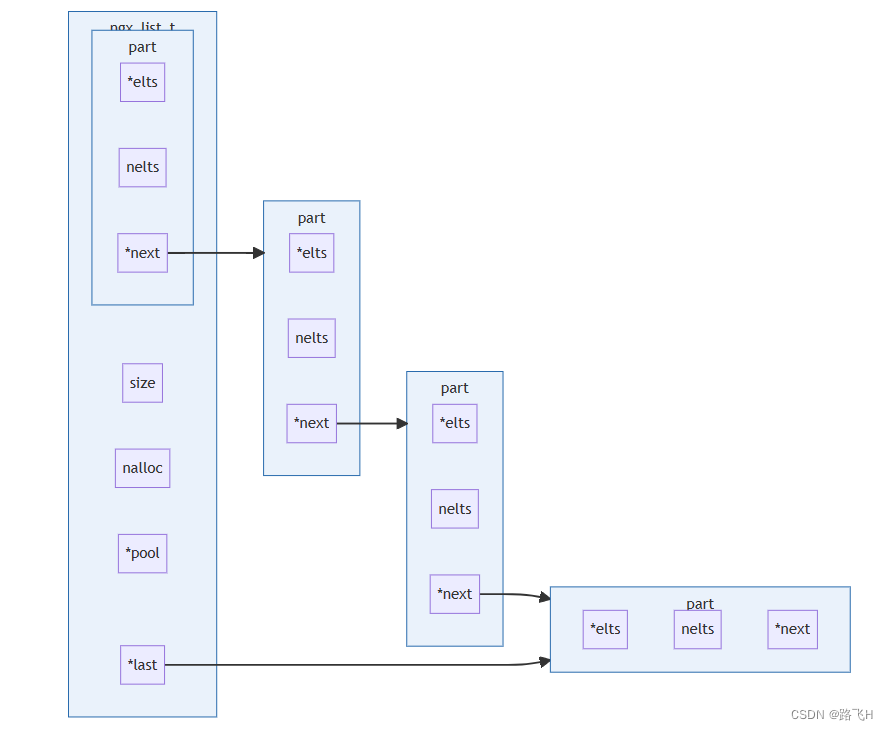
二、Nginx 组件的使用
Nginx的内存池分成大小块,小块是要么不释放要么全部释放。ngx_create_pool(size_t size, ngx_log_t *log)里的size就是用来区分大小块的,大于size的就是大块,否则就是小块。
2.1、makefile的编写
CXX = gcc
CXXFLAGS += -g -Wall -Wextra
NGX_ROOT = /home/fly/workspace/nginx-1.13.7
TARGETS = ngx_code
TARGETS_C_FILE = $(TARGETS).c
CLEANUP = rm -f $(TARGETS) *.o
all: $(TARGETS)
clean:
$(CLEANUP)
CORE_INCS = -I. \
-I$(NGX_ROOT)/src/core \
-I$(NGX_ROOT)/src/event \
-I$(NGX_ROOT)/src/event/modules \
-I$(NGX_ROOT)/src/os/unix \
-I$(NGX_ROOT)/objs \
-I$(NGX_ROOT)/../pcre-8.41 \
-I$(NGX_ROOT)/../openssl-1.1.0g/include/ \
NGX_PALLOC = $(NGX_ROOT)/objs/src/core/ngx_palloc.o
NGX_STRING = $(NGX_ROOT)/objs/src/core/ngx_string.o
NGX_ALLOC = $(NGX_ROOT)/objs/src/os/unix/ngx_alloc.o
NGX_ARRAY = $(NGX_ROOT)/objs/src/core/ngx_array.o
NGX_HASH = $(NGX_ROOT)/objs/src/core/ngx_hash.o
NGX_LIST = $(NGX_ROOT)/objs/src/core/ngx_list.o
NGX_QUEUE = $(NGX_ROOT)/objs/src/core/ngx_queue.o
$(TARGETS): $(TARGETS_C_FILE)
$(CXX) $(CXXFLAGS) $(CORE_INCS) $(NGX_PALLOC) $(NGX_STRING)
$(NGX_ALLOC) $(NGX_ARRAY) $(NGX_LIST) $(NGX_QUEUE) $(NGX_HASH) $^ -o $@
注意nginx的源码路径以及所需库的路径,要写正确的。
2.2、ngx_palloc+ngx_array的使用
#include <stdio.h>
#include "ngx_config.h"
#include "ngx_conf_file.h"
#include "nginx.h"
#include "ngx_core.h"
#include "ngx_string.h"
#include "ngx_palloc.h"
#include "ngx_array.h"
//#include "ngx_hash.h"
typedef struct {
int id;
int level;
}ngx_fly_t;
// 打印内存池的数据信息
void print_pool(ngx_pool_t *pool)
{
while (pool)
{
printf("avail pool memory size: %ld\n\n",
pool->d.end - pool->d.last);
pool=pool->d.next;
}
}
volatile ngx_cycle_t *ngx_cycle;
#define unused(x) (x)=(x)
void ngx_log_error_core(ngx_uint_t level, ngx_log_t *log, ngx_err_t err,
const char *fmt, ...)
{
unused(level);
unused(log);
unused(err);
unused(fmt);
}
int main()
{
ngx_str_t str = ngx_string("Hello World!");
printf("string length: %ld\n", str.len);
printf("string: %s\n", str.data);
// 创建内存池
ngx_pool_t *pool;
pool = ngx_create_pool(1024, NULL);
print_pool(pool);
// 创建数组
/*
* nalloc = 32
* size = sizeof(ngx_fly_t)
* pool = pool
*/
ngx_array_t *arr = ngx_array_create(pool, 32, sizeof(ngx_fly_t));
print_pool(pool);
ngx_fly_t *t1 = ngx_array_push(arr); // 拿出内存
t1->id = 101; //赋值
t1->level = 1; //赋值
print_pool(pool);
ngx_fly_t *t2 = ngx_array_push(arr); // 拿出内存
t2->id = 102; //赋值
t2->level = 3; //赋值
print_pool(pool);
return 0;
}
使用makefile来编译,执行结果:
$ ./ngx_code
string length: 12
string: Hello World!
avail pool memory size: 944
avail pool memory size: 648
avail pool memory size: 648
avail pool memory size: 648
可以看到:
- 代码中分配的内存池是1024,分配之后只有944可以用,有80字节被使用了。这80字节其实是被内存池的头占用了(ngx_pool_t)。
- 分配完一个32的数组后,内存池还剩余的内存为648,也就是32*8=256被分配给了数据。
- 数组内存分配好之后,使用数组元素已经不会再去申请内存池的内存。
- 如果数组元素用完了,还调用ngx_array_push会怎么样?从ngx_array.c的源码中可以发现,它会动态扩容数组,重新分配2*size。
2.3、ngx_palloc+ngx_list的使用
#include <stdio.h>
#include "ngx_config.h"
#include "ngx_conf_file.h"
#include "nginx.h"
#include "ngx_core.h"
#include "ngx_string.h"
#include "ngx_palloc.h"
#include "ngx_array.h"
//#include "ngx_hash.h"
typedef struct {
int id;
int level;
}ngx_fly_t;
// 打印内存池的数据信息
void print_pool(ngx_pool_t *pool)
{
while (pool)
{
printf("avail pool memory size: %ld\n\n",
pool->d.end - pool->d.last);
pool=pool->d.next;
}
}
volatile ngx_cycle_t *ngx_cycle;
#define unused(x) (x)=(x)
void ngx_log_error_core(ngx_uint_t level, ngx_log_t *log, ngx_err_t err,
const char *fmt, ...)
{
unused(level);
unused(log);
unused(err);
unused(fmt);
}
int main()
{
ngx_str_t str = ngx_string("Hello World!");
printf("string length: %ld\n", str.len);
printf("string: %s\n", str.data);
// 创建内存池
ngx_pool_t *pool;
pool = ngx_create_pool(1024, NULL);
print_pool(pool);
ngx_list_t *list=ngx_list_create(pool, 32, sizeof(ngx_fly_t));
print_pool(pool);
ngx_fly_t *t3 = ngx_list_push(list); // 拿出内存
t3->id = 103; //赋值
t3->level = 3; //赋值
print_pool(pool);
ngx_fly_t *t4 = ngx_list_push(list); // 拿出内存
t4->id = 104; //赋值
t4->level = 4; //赋值
print_pool(pool);
return 0;
}
使用makefile来编译,执行结果:
$ ./ngx_code
string length: 12
string: Hello World!
avail pool memory size: 944
avail pool memory size: 632
avail pool memory size: 632
avail pool memory size: 632
可以发现,ngx_list相比ngx_array少了(648 − 632 = 16)字节,从源码的ngx_list_create()函数可以发现,是因为多了一个ngx_list_t的头数据。
总结
这里对ngx_string、ngx_array、ngx_list做了简单介绍和提供使用示例,其他的nginx基础组件的使用(比如dequeue、hash、log等等)也是类似的。

